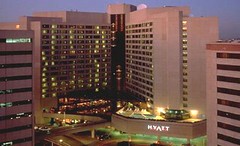Habitable sculptures or great places? That's the conundrum for planning and development
The architecture critic of the New York Times isn't happy with planning, because he doesn't see it as yielding great architecture. See "Profit and Public Good Clash in Grand Plans." My problem with typical big project planning is that it doesn't yield very nice places. Starchitecture isn't about place and context, it's about the "artist-sculptor" as architect. Or it's about Auto-CAD and churning out building designs.
He writes, about the West Side railyard proposal:
The current proposal essentially takes off where that earlier plan left off by championing profit over the public good. Rising on a vast platform to be built over the train tracks, the project is conceived as a series of soaring corporate and residential towers flanking the northern and southern ends of a narrow park running from 10th Avenue to the West Side Highway, between 30th and 33rd Streets. City officials say the deal will generate $1 billion in income over a 99-year lease.
Designed by Murphy/Jahn, the buildings are a throwback to the days when corporate Modernism was taking its dying breaths. Towering glass blocks, their most original features are a series of deep cantilevers that allow the developer to suspend buildings over the High Line, the public park being built on a stretch of abandoned elevated tracks in Chelsea. (The cantilevers are an obvious reference to the bases of the 1978 Citicorp Center and the former I.B.M. Building of 1983, though at a blown-up scale.) ...
Equally unsettling is how the project fits into the surrounding urban fabric. The towers loom over the High Line, forming a colossal barrier against the Chelsea neighborhood to the south. (Allowing 11th Avenue to run through the site will lessen the effect slightly, but not much.) Arranging the towers along an east-west axis — a break from the traditional Manhattan grid — is only apt to reinforce the site’s image as an introverted corporate enclave.) ...
If recent history teaches us anything, it is that the project is only likely to get worse. This is because of the nature of the urban planning process in New York, which tends to lock in the worst parts of a design while allowing a developer to chip away at what is most original and often most costly.
For a somewhat similar kind of article, see "The Mediocre Mile," from the Post by Philip Kennicott. Although I think my definition of urban design and place making (places for people, not places to look at from the air) are different from the perspective of both writers.
I think about this a lot as the city east of the Central Business District is becoming reproduced into more office or office-like ghetto, as proposed housing looks just like an office building too.
See the Washington Gateway project blog entry ("Gateway On Its Way") from DC Metro Urban Diaries as well as the entry on the proposed mixed use building at 4th and Florida Avenue NE by the odious team of Choi, ex-Councilmember now development lawyer John Ray, and the crew of people who see value in using the levers of government power to grease the ability to make profits at the expense of other businesspeople. See "New Town at Capitol City, a Neighborhood Takes Shape" also from DC MUD.

Proposed building for the Florida Market site at 4th and Florida Ave. NE

Washington Gateway abutting the CSX railroad tracks, north of New York Avenue NE

Crystal City
These buildings could be on K Street NW or in Crystal City or on M Street SE or in any office ghetto in the region, or anyplace else for that matter.
From the top of the New York Avenue bridge, you can see the Washington Cathedral. From the McKinley Tech high school campus, you can see much of the city as well.
Soon enough, the view will be of mostly of glass office or office-like buildings, interspersed with rowhouses.
Labels: urban design/placemaking



0 Comments:
Post a Comment
<< Home